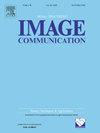理解,检测和去除压缩视频中的感知带伪影
IF 2.7
3区 工程技术
Q2 ENGINEERING, ELECTRICAL & ELECTRONIC
引用次数: 0
摘要
条带伪影或虚假轮廓是一种常见的压缩损伤,通常出现在编码视频和图像的大块平滑区域上。这些阶梯状的色带可能非常明显且令人讨厌,即使在高质量的视频上也是如此,尤其是在高清屏幕上显示时。然而,对这个问题的关注相对较少。本文首先分析了带伪影的感知和编码方面,然后在感知模型的启发下,提出了一种新的针对失真的无参考视频质量算法来预测带伪影。提出的条带检测器可以生成逐像素的条带可见性图,并在帧和视频级别输出总体条带严重程度评分。此外,我们提出了一种基于深度学习的方法,通过联合去条带和压缩伪影去除来提高压缩视频的整体感知质量。实验结果表明,所提出的波段检测器与主观评价具有更好的一致性,并且能够检测到不同的波段感知严重程度。实验还表明,该算法在视觉上和定量上都优于现有的去条带模型。代码可在https://github.com/google/bband-adaband和https://github.com/vztu/DebandingNet上获得。本文章由计算机程序翻译,如有差异,请以英文原文为准。
Understanding, detecting, and removing perceptual banding artifacts in compressed videos
Banding artifacts, or false contouring, are a common compression impairment that often appears on large smooth regions of encoded videos and images. These staircase-like color bands can be very noticeable and annoying, even on otherwise high-quality videos, especially when displayed on high-definition screens. Yet, relatively little attention has been applied to this problem. Here we study this artifact, by first analyzing the perceptual and encoding aspects of banding artifacts, then propose a new distortion-specific no-reference video quality algorithm for predicting banding artifacts, inspired by perceptual models. The proposed banding detector can generate a pixel-wise banding visibility map, and output overall banding severity scores at both the frame and video levels. Furthermore, we propose a deep learning based approach to improve the overall perceptual quality of compressed videos by joint debanding and compression artifact removal. Our experimental results show that the proposed banding detector delivers better consistency with subjective evaluations, and is able to detect different perceptual severity levels of bands. The debanding experiments also show that the proposed algorithm outperforms recent debanding models both visually and quantitatively. The code is available at https://github.com/google/bband-adaband and https://github.com/vztu/DebandingNet.
求助全文
通过发布文献求助,成功后即可免费获取论文全文。
去求助
来源期刊

Signal Processing-Image Communication
工程技术-工程:电子与电气
CiteScore
8.40
自引率
2.90%
发文量
138
审稿时长
5.2 months
期刊介绍:
Signal Processing: Image Communication is an international journal for the development of the theory and practice of image communication. Its primary objectives are the following:
To present a forum for the advancement of theory and practice of image communication.
To stimulate cross-fertilization between areas similar in nature which have traditionally been separated, for example, various aspects of visual communications and information systems.
To contribute to a rapid information exchange between the industrial and academic environments.
The editorial policy and the technical content of the journal are the responsibility of the Editor-in-Chief, the Area Editors and the Advisory Editors. The Journal is self-supporting from subscription income and contains a minimum amount of advertisements. Advertisements are subject to the prior approval of the Editor-in-Chief. The journal welcomes contributions from every country in the world.
Signal Processing: Image Communication publishes articles relating to aspects of the design, implementation and use of image communication systems. The journal features original research work, tutorial and review articles, and accounts of practical developments.
Subjects of interest include image/video coding, 3D video representations and compression, 3D graphics and animation compression, HDTV and 3DTV systems, video adaptation, video over IP, peer-to-peer video networking, interactive visual communication, multi-user video conferencing, wireless video broadcasting and communication, visual surveillance, 2D and 3D image/video quality measures, pre/post processing, video restoration and super-resolution, multi-camera video analysis, motion analysis, content-based image/video indexing and retrieval, face and gesture processing, video synthesis, 2D and 3D image/video acquisition and display technologies, architectures for image/video processing and communication.
 求助内容:
求助内容: 应助结果提醒方式:
应助结果提醒方式:


